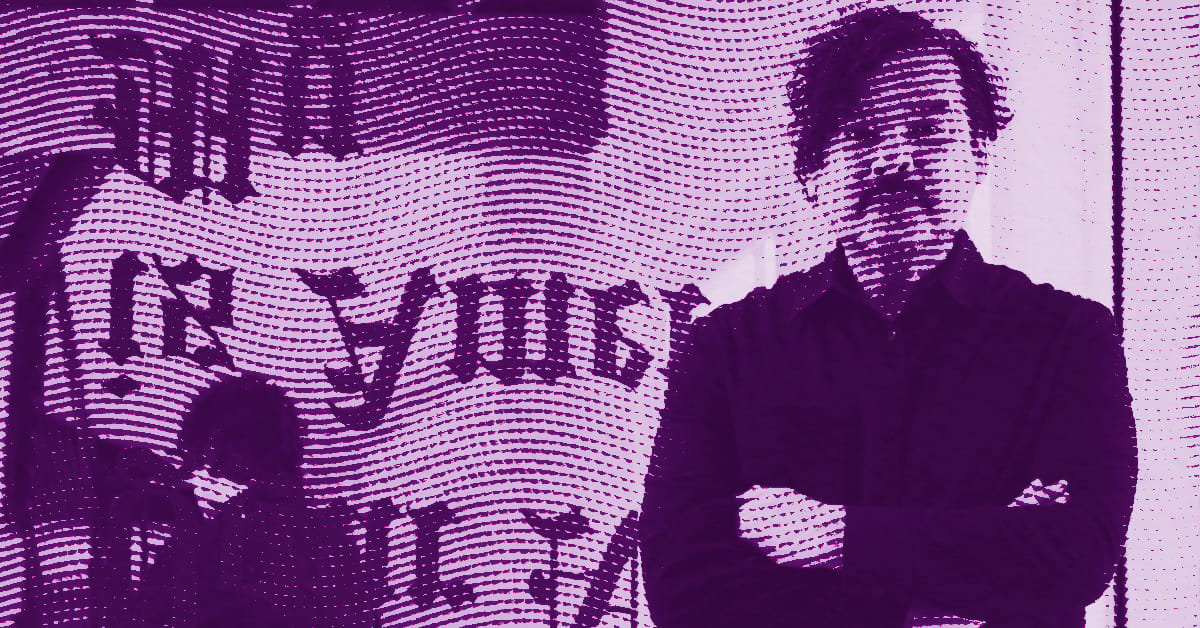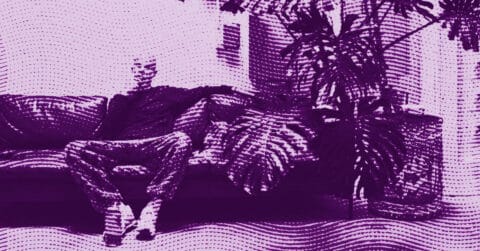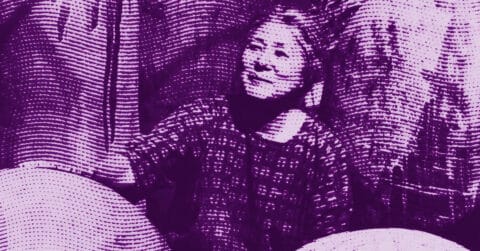Listen to me carefully, you bunch of snobs: if you still believe that contemporary art is limited to a few bold brushstrokes on a white canvas or narcissistic installations in sterile galleries, prepare for Julio César Morales to overturn your cozy certainties. This artist born in Tijuana has no use for your narrow aesthetic conventions. His work, a true visual chronicle of the migrant condition, stands as one of the most incisive proposals of contemporary American art. But beware: he is not an activist armed with simplistic slogans; he is a poet armed with watercolors, a composer whose instrument is the collective memory of a people in perpetual motion.
Morales operates at the border, geographically, certainly, but above all conceptually, between two nations, two languages, two imaginaries. This liminal position is not an intellectual pose chosen to look nice in a press kit. The artist literally grew up in Tijuana’s Zona Norte before his family moved, when he was ten, in one block to San Ysidro, California. One block. This trivial distance nonetheless contains all the violence of a geopolitical separation whose consequences are measured in broken lives. “I grew up crossing the border every day until I was twenty,” he confides [1]. This is not a biographical anecdote; it is the raw material of his art.
Cinema as the grammar of the gaze
When Morales declares that he is “a musician, but [that his] instrument is visual art” [2], this is not a convenient metaphor. His practice indeed borrows from film editing, the narrative construction of documentary film, the visual economy of Italian neorealism. Think of Vittorio De Sica filming Roman streets in Bicycle Thieves: the same attention paid to anonymous people, the same refusal of easy pathos, the same dignity accorded to marginalized figures. Morales does not illustrate suffering; he frames it. He does not denounce; he shows. A crucial nuance in an art landscape saturated with moralizing good intentions.
His work on The Border, a 1982 Hollywood film starring Jack Nicholson, constitutes a remarkable exercise in détournement in this respect. In his videos “The Border (Los Pollos vs. La Migra)” and “We Don’t See” (both 2025), Morales undertakes a cinematic rewriting that is neither simple critical commentary nor parody. By cutting out the silhouette of the main actor on the film’s original posters, by filtering images to erase protagonists in favor of extras, the artist performs an act of poetic justice: he makes visible what Hollywood had chosen to ignore. The migrants, in his editing, are no longer shadows serving a heroic narrative centered on a white border agent. They become the true subjects of the story.
This quasi-documentary approach runs through his entire body of work. The watercolors in the Undocumented Interventions series, begun in 2010, function like freeze frames from a horror film whose reality surpasses fiction. Human bodies hidden in car dashboards, concealed in audio speakers, folded inside piñatas shaped like cartoon characters, SpongeBob, Barney. The absurd coexists with the tragic with an immediacy that evokes the best Latin American auteur cinema, the kind that rejects the picturesque to embrace reality in all its prosaic brutality.
Morales constructs his images like a filmmaker composes his shots: by accumulating meaningful details, by juxtaposing temporalities, by layering points of view. His multimedia installations do not merely show; they create immersive devices. The sound installation My America Is Not Your America, created in collaboration with the Mexican Institute of Sound, transforms the exhibition space into a listening room, a political meditation booth. Visitors enter it two at a time, a deliberate constraint that mimics the forced intimacy of bodies in the Gemelos series. The red neon accompanying this installation literally traces the border between the United States and Mexico, but in reverse, as if the world had flipped. Exactly like when crossing over.
Sociology of the open wound
If Morales works as a filmmaker, he thinks like a sociologist. His work fits within an intellectual lineage that goes far beyond artistic testimony to constitute a true analysis of border mechanisms. Gloria Anzaldúa, a major Chicana theorist, wrote in 1987 that “the border between the United States and Mexico is an open wound where the Third World grates against the first and bleeds” [3]. This formulation, of striking poetic violence, could serve as a subtitle for Morales’s entire corpus.
But where Anzaldúa theorized the “mestiza consciousness,” that fragmented and recomposed identity of border subjects, Morales offers a visual embodiment. His watercolors are not illustrations of a preexisting theory; they are the theory itself, translated into plastic language. Each image in the Gemelos series constitutes a miniature thesis on liminal space, that non-place where individuals cease to belong to their country of origin without yet having joined that of destination. In these perilous interstices, sociology meets ontology: what does it mean to be human when all the social structures that defined you have collapsed?
The artist uses watercolor, a delicate medium if there ever was one, to represent these clandestine passages. “Its delicacy allows me to add a sense of tenderness to the painful and often violent experiences endured by people trying to cross the border,” he explains [4]. A technical choice that is also an ethical choice: to reject sensationalism, to prefer chromatic softness over gore representation. It is precisely this formal restraint that makes the work so devastating. The intertwined bodies in confined spaces evoke both the womb and the coffin, rebirth and death. This structural duality also refers to the Maya myth of the hero twins from the Popol Vuh, who also cross portals between worlds, die and are reborn, sacrifice themselves to access a new existence.
The sociological vocabulary of the informal economy also permeates his work. Morales methodically documents the survival strategies deployed by migrants: human trafficking, clandestine crossings, parallel economies. But he stubbornly refuses any moral hierarchy. The “coyotes,” smugglers, are part of his family, just like judges and police officers. This family complexity reflects the sociological complexity of the border zone itself, a space where the usual categories of legal and illegal, good and evil, lose their relevance. This is not moral relativism but sociological realism: in these in-between territories, survival imposes rules that state bureaucracies can neither understand nor regulate.
The neon lights that Morales frequently uses constitute a visual signature but also a sociological marker. This red light, reminiscent of the signs in Tijuana, the bars of Avenida Revolución, places the work within a specific geography while giving it a universal dimension. Neon, a technology of commercial visibility, becomes here an instrument of social revelation. The installation Las Líneas 2028/2022/1845/1640 traces four successive historical borders, recalling that these supposedly immutable lines have continuously shifted with conquests, treaties, wars. The border is not a natural fact; it is a historical construction and therefore reversible, modifiable, and contestable.
The poetics of the portal
The eight watercolors of the series Gemelos, recently presented at Gallery Wendi Norris in San Francisco (from September 19 to November 1, 2025), deserve special attention. Morales depicts pairs of bodies, hence the title “twins,” compressed into impossible spaces. These spaces, the artist explicitly conceives as portals: thresholds between two states of existence, passages between two worlds. The imagery refers to the pre-Columbian myth while documenting a verifiable contemporary reality: photographs actually circulate showing children hidden in the padding of car seats to cross the border clandestinely.
The visual ambiguity of these intertwined bodies, are they being born or dying?, is not a gratuitous aesthetic effect. It expresses the fundamental ambivalence of the migratory experience: every departure is a little death, every arrival an uncertain rebirth. The migrants Morales portrays occupy a paradoxical existential position, comparable to that of the Maya twin heroes who had to die to be reborn transformed. Except that for contemporary migrants, resurrection is never guaranteed. Some die in these narrow passages, suffocated, crushed. Others survive but carry forever the psychic scars of that crossing.
The white of the watercolor surrounding these bodies functions as an ontological void, a suspension space where the usual coordinates of existence dissolve. Not yet there, no longer here, “ni de aquí ni de allá,” as the Spanish expression says. This intermediate zone, this “third space” that Morales talks about in his interviews, constitutes the true subject of his art. Not the border as a demarcation line, but the border as an existential condition, as a mode of being in the world.
His recent installation tomorrow is for those who can hear it coming, a twisted quote from a David Bowie advertising slogan, raises a question as simple as it is terrible: in the current political climate, who has the privilege of having a future? ICE raids, xenophobic rhetoric, mass expulsion policies create a situation where some human beings are literally denied the right to imagine their tomorrow. Morales’ neon sign, with its gothic script borrowed from Chicano lowrider culture, nonetheless asserts a form of resistance: hearing tomorrow coming means refusing to be reduced to the immediate present of survival.
Towards an ethics of the gaze
A truth becomes obvious: we are facing an artist who has understood that representation is never neutral, that showing is already taking a stand. But unlike so many of his contemporaries who turn art into a militant platform, Morales works with a subtlety that respects the intelligence of the viewer. He does not dictate what to think; he creates conditions for possible thought.
His systematic use of found materials, real documents, preexisting images resembles both an archivist’s and an artist’s methodology. Each work functions as a piece of evidence in a trial that will never take place, one that would judge migration policies for what they truly are: machines that crush humans. The delicate watercolors, luminous neon lights, sound installations together compose a form of memorial for the disappeared at the border, those thousands of anonymous people whose deaths will never headline the news.
What makes Morales’ work so necessary today is precisely his refusal of easy pathos. No tearfulness, no performative outrage, no guilt-tripping of the viewer. Just a factual presentation of unbearable situations, accompanied by a formal gentleness that makes it all the more unbearable. Because that is exactly what it is about: making the unbearable visible, giving shape to the unacceptable, without ever falling into the obscenity of over-representation.
The artist recently declared: “I want to give value and pay tribute to the work of immigrants and their lives, not only from Latin America but from around the world.” This ambition might seem naive in its simplicity. It is not. On the contrary, it is of absolute radicality in a context where the very existence of these people is denied, where their humanity is systematically denied by dominant political discourses. Making visible is resisting. Bearing witness is fighting.
Morales patiently builds, work after work, a counter-archive of the border. Where the media see only numbers, arrests, expulsions, deaths at sea or in the desert, he sees individuals. Where political discourse perceives only a “migration crisis”, he identifies survival strategies, solidarity networks, parallel economies, hybrid cultures. His art is political not despite its poetic dimension, but precisely because of it. Poetry here becomes a tool of knowledge, a mode of access to realities that rational discourses fail to grasp.
The current retrospective at the Jan Shrem and Maria Manetti Shrem Museum of Art at the University of California, Davis, from August 7 to November 29, 2025, arrives just in time. It allows us to measure the coherence of a journey that spans over thirty years, from the first performative interventions to the recent multimedia installations. This coherence is not that of a fixed style but that of an obsessive concern: how to represent with dignity those whom the contemporary world has decided to render invisible?
At a time when contemporary art too often indulges in self-referential formal games or stance activism, Morales reminds us that an artist can be both rigorously formal and deeply committed. That plastic beauty is not incompatible with political urgency. That the delicacy of a watercolor can carry more critical weight than a thousand vengeful manifestos. His work shows that one can speak of the most brutal reality with the most refined means, that one can document horror without giving up formal grace.
Ultimately, and perhaps this is his most valuable contribution, Julio César Morales offers us a lesson in radical humanism. Not that abstract and comfortable humanism that celebrates Man with a capital M from the comfort of an academic armchair, but a concrete humanism, rooted in suffering bodies, broken trajectories, mutilated hopes. A humanism that knows dignity is not proclaimed, it is built in the way we look at others. And the gaze Morales casts on migrants is never condescending, never miserabilist. It is an equal-to-equal gaze, that of a man who himself crossed the line and knows what that means.
His art reminds us that behind every migration statistic hides a singular life, a family network, a personal story. That reducing these existences to their administrative status, legal, illegal, documented, undocumented, is a form of symbolic violence as devastating as the physical violence endured during crossing. Morales restores these anonymous individuals their full humanity, not through moralizing speech, but by the sheer power of artistic representation. He offers them what society refuses: visibility, presence, inscription in the collective history.
That’s why his work will remain relevant long after current political debates have faded. Because it touches on something universal and timeless: the condition of the exile, the pain of uprooting, the complexity of mestizo identity. Because it asks the right questions without claiming to hold the answers. Because it forces us to look at what we would prefer to ignore, while offering us enough formal beauty to make that gaze bearable. Between the violence of reality and the softness of watercolor, Julio César Morales has found the exact balance that defines great art: art that enlightens without blinding, that wounds without destroying, and that witnesses without exhausting itself in testimony.
- Natasha Boas, “Julio César Morales Looks at Life on the Edge-Lands”, Hyperallergic, November 3, 2025
- Mary Corbin, “Julio César Morales’ tender work renders the pain of migration”, 48 Hills, October 7, 2025
- Gloria Anzaldúa, Borderlands/La Frontera: The New Mestiza, Aunt Lute Books, 1987
- Mary Corbin, “Julio César Morales’ tender work renders the pain of migration”, 48 Hills, October 7, 2025
















